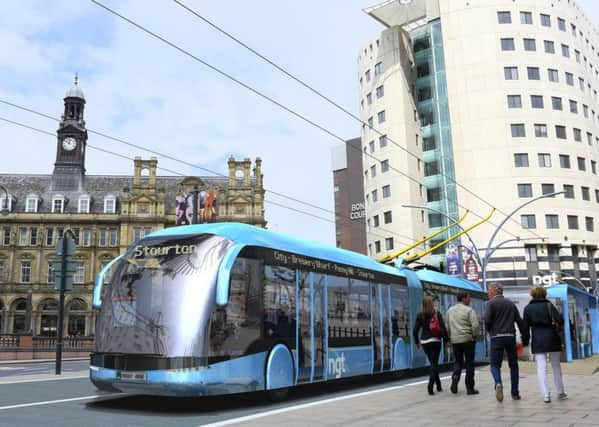YP Comment: Wheels still not in motion - Leeds' trolleybus plans in limbo


But in Leeds they have been waiting for the arrival of the trolleybus system for much longer than that. Plans were first put forward after the then Labour government pulled the plug on the city’s £500m Supertram light rail scheme in 2005, amid concern over spiralling costs.
Since then it has been a sorry saga of disagreements and delays. So the fact that Leeds is still in the dark about the fate of its trolleybus project – nearly 18 months after the completion of a public inquiry into the scheme – should perhaps come as little surprise.
Advertisement
Hide AdAdvertisement
Hide AdThe Government is deciding whether to give the £250m project the green light, with the help of a report drawn up by the inspector who headed the inquiry in 2014, and Ministers were expected to reveal their verdict at the end of last year, or at the start of this. But the people of Leeds are still waiting.
The Department for Transport (DfT) is now looking at the report but won’t say when a final decision will be made. This delay has, not surprisingly, been criticised by transport campaigners who see the scheme as a viable way of reducing the huge amount of traffic on the city’s roads.
The problem, though, is it has divided opinion with supporters claiming it would create up to 4,000 jobs and boost the city’s economy by £175m each year, while critics argue that it is poor value for money and would damage the environment.
However, the fact remains that the longer this drags on the longer the city – a key pillar in the Chancellor George Osborne’s vision of the Northern Powerhouse – is without a meaningful public transport strategy. Which simply isn’t good enough.
Advertisement
Hide AdAdvertisement
Hide AdThe clock is still ticking, just don’t expect to see a trolleybus in Leeds any time soon.
Leadership issues
Corbyn is Labour’s biggest problem
From the moment he was elected Labour Party leader back in September, Jeremy Corbyn’s position has been under scrutiny. He swept to victory on a wave of enthusiasm for his anti-austerity message and the promise to scrap Britain’s nuclear weapons and renationalise the railways and major utilities. The only problem is that many high-profile figures within his own party disagree with his key policies.
In recent months these disagreements have become all too apparent, highlighted by his Shadow Cabinet reshuffle in January that saw popular and effective figures like Barnsley East MP Michael Dugher being jettisoned. The schisms some feared Mr Corbyn’s leadership would create within the party are now being borne out.
Recent speeches by Yorkshire MPs Dan Jarvis and Rachel Reeves have been widely interpreted as challenging his leadership of the party. But Mr Corbyn says he is unconcerned by any political manoeuvering and insists it is a symbol of the type of “open” party he wants to create.
Advertisement
Hide AdAdvertisement
Hide AdBut the problem is the Labour Party Mr Corbyn wants and the one that the British people need, are two different things. At a time when it should be holding the Government to account on crucial issues such as devolution, flooding policies and the Northern Powerhouse, the party is engaged in petty squabbles.
What this country needs is a strong Opposition with a credible and, more importantly, electable leader at the helm. And the feeling among too many people is that Mr Corbyn and his cronies are more suited to waving placards than building an Opposition worthy of the name.
Best foot forward
Is it time to kick off our shoes?
Getting out of our comfort zone is the first thing we are always told when looking to turn over a new healthy chapter in our lives.
The idea of walking barefoot around Yorkshire’s famous countryside might not appeal to many, but the science is hard to ignore.
Advertisement
Hide AdAdvertisement
Hide AdBeing barefoot is said to improve one’s gait, growth and muscle tone as our feet did not evolve to wear shoes.
Our ancient ancestors evolved the way they did due to their ability to walk and run long distances in the pursuit of animals they wished to eat, so called “persistence hunting”. A handful of tribes in Africa practice it to this day.
Indeed there is much evidence to suggest that distance runners and other endurance athletes only began to encounter knee and hip injuries with the advent of the running shoe industry.
To this end, the actions of Hayley Gillard from Otley in creating a barefoot walking club should at the very least merit interest and at best encourage us to give it a try.